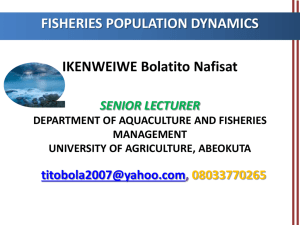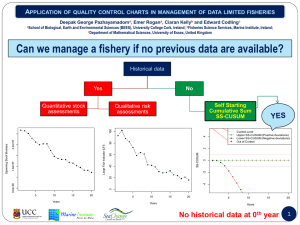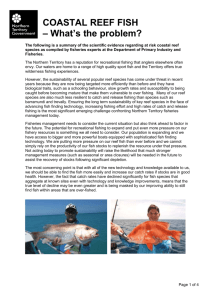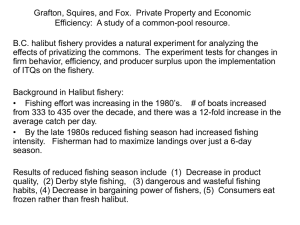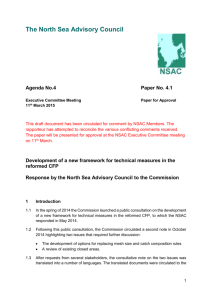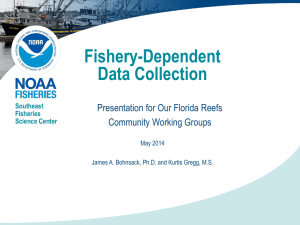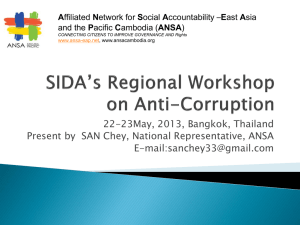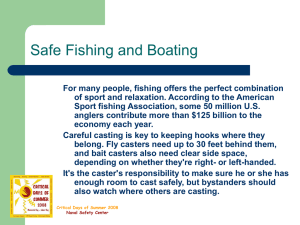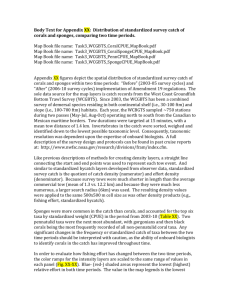Growing recreational impact, often declining commercial impact
advertisement
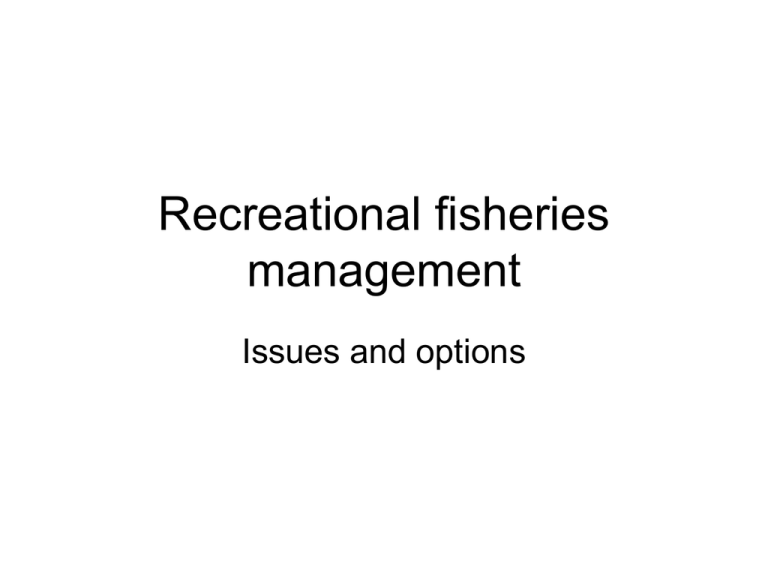
Recreational fisheries management Issues and options Recreational fisheries are IMPORTANT • According to NMFS, the total landed value of US commercial fisheries in 2009 was $2.29 billion (FAO says $31 billion, not clear why since doesn’t agree with tonnage reported to FAO) • US marine recreational fisheries were valued at of $12 billion, almost 1/3 Florida Characteristics of recreational fisheries • Most often “open access”, no effort limitation • Very high economic value to small communities, rural areas (shift leisure spending from urban activities) • Typically take over from commercial fisheries when in competition (strong political voice, lots of voters) • Rarely cause biological overfishing (effort responds strongly to reduced abundance) • Create severe quantity-quality tradeoff problem Vulnerability exchange process typically limits catch per effort Invulnerable fish Smart, inactive, resident in safer places (eg deep) vulnerable fish Stupid, active, resident in places where gear works and access is best, typically <10% of total fish cpue Vulnerable density (cpue) CPUE typically very sensitive to fishing effort Fishing effort • CPUE often 510x higher at low efforts, because first increments in effort enjoy high catch rates, deplete vulnerable pool (foraging arena equation effect) Fishing effort Effort responses prevent increases in cpue Total Fish Abundance • Typical response is nearly linear • Linear increase predicted if vulnerable density held roughly constant: c=co/(1+qE) E=1/q(co/c-1) (co=cpue at zero effort, c=cpue at equilibrium) Approaches to recreational fisheries regulation • Size and bag limits (almost universal) • Seasonal closures (common) • Production side, hatcheries (common, do not increase cpue) • Spatial closures, MPAs (uncommon so far) • Limited entry--access management, license lotteries, etc. (very uncommon) This will not be an objective presentation; my interest is in insuring that Junior and I can keep doing this Growing recreational impact, even with restrictive bag and size limits, as for gag grouper in the Gulf of Mexico Growing recreational impact often simply replaces commercial impact Pompano, West Florida Coast 600000 500000 Catch 400000 Commercial Sport Commercial Net ban 300000 200000 100000 0 1982 1984 1986 1988 1990 1992 1994 1996 1998 2000 Book/Pompano.xls So we are going to face progressively more severe restrictions as demand for both fishing and conservation grow • • Open access fisheries lead to a syndrome of “success breeds failure”: effort expands until quality of fishing declines There are two basic ways to restrict fishing mortality in open-access fisheries: – – • Reduce effective effort through bag limits, size limits, closed seasons Spatial closures (protected areas) Spatial and seasonal closures lead to concentration of fishing near closed area boundaries and at season openings The quality-quantity tradeoff: Most of us end up getting screwed, most of the time Quantity (angling effort) Quality (cpue, size) LOW COST Unguided HIGH COST Guided Cedar Key (10 min.) Vancouver (2 hr travel) Public access Suwanee (60 min.) Chilcotin (7 hr travel) Private Most of us hate the very idea of spatial closures; I certainly do • But then I got to thinking about why I can still catch lots of spotted sea trout and red drum in my back yard in Cedar Key, Florida: most of the time, most of those fish are not in spots where people can catch them, i.e. the fish are in natual “marine protected areas” • And I started connecting that thinking with the stock assessment and modeling work that I do when I replace my fishing hat with my scientist hat (which thankfully isn’t too often anymore). Mindless combination of size and bag limits can even cause worse conservation problems 25 23 21 0.8-1 19 17 0.6-0.8 0.4-0.6 0.2-0.4 15 Size Lim it 0-0.2 13 11 9 9 7 5 3 7 1 In this grouper example, green represents healthy recruitment levels, and red is severe overfishing. For low bag limits, increasing the size limit actually causes recruitment to decrease (move from green to yellow zone). 5 Bag Lim it Combining these regulations is kind of like taking Viagra and Valium at the same time: it might work, but… Recent models for predicting redistribution of fish and fishing when areas are protected (MPAs) indicate that sustainable sport effort should often increase as closed area is increased Total sport fishing effort sustained Not enough fishing ground Not enough fish 0% Area closed to fishing 100% EDOM model predictions of Gulf of Mexico red snapper fishing effort EDOM random MPA siting algorithm Gulf of Mexico red snapper Equilibrium fishing effort 60 50 40 30 20 10 0 0 20 40 60 80 Percent of total area closed 100 For the red snapper example, MPAs might result in widely higher efforts, not just at MPA boundaries Gulf of Mexico red snapper EDOM prediction No MPAs Optimum MPA design 1.2 1 0.8 0.6 0.4 0.2 0 TX TX TX TX TX TX TX TX TX TX TX TX TX LA LA LA LA MS MS MS MS MS AL AL AL FL FL FL FL FL FL FL Equilibrium fishing effort 1.4 Coastal location (Texas to Florida) A promising alternative: rotating closures (fallow rotation) • Advantages – Increased total yield when discard mortality is high – Larger average fish size if used with size limits – Increased cpue and number of fish kept – Assures meeting Federal fishing mortality rate limits • Disadvantages – Effort concentration, competition – Low cpue late in openings – Encourages cheating (enforcement issue) Rotating closures for West Florida grouper management OPENINGS: 2008, 2012, … 2009, 2013, … 2010, 2014, … 2011, 2015, … Strips as shown are 0.1 degree (6 nm, 10 km) north-south; larger strips would be safer, but would more seriously limit local access to good grounds Year 80 60 40 20 0 2028 2026 2025 2023 2022 2020 2019 2017 2016 2014 2013 2011 2010 2008 2007 2005 2004 2002 2001 1999 1998 1996 1995 1993 1992 1991 1989 1988 1986 2032 100 2031 120 2032 CATCH PER EFFORT 2031 But catch per effort could be depressed 2029 Year 2029 2028 2026 2025 2023 2022 2020 2019 2017 2016 2014 2013 2011 2010 2008 2007 2005 2004 2002 2001 1999 1998 1996 1995 1993 1992 1991 1989 1988 1986 Catch/effort (kg/day) Total Catch (mt) Predicted gag grouper performance Annual total catch should remain high CATCH 3000 2500 2000 1500 1000 500 0 Gag grouper policy options and performance tradeoffs Policy MSY (Current policy, 51 cm size) Rotating, 51 cm min size Rotating, no min size Yield (mt) 2281 2455 2369 Catch Trophy Catch Egg Waste (1000 fish) (1000 fish) production (1000 fish) 622 133 15.33 264 574 169 15.06 234 1485 129 13.63 0 Even if we permanently solve conservation problems by using closed areas (MPAs, rotating openings), this problem will remain: Most of us end up getting screwed, most of the time Quantity (angling effort) Quality (cpue, size) LOW COST Unguided HIGH COST Guided Cedar Key (10 min.) Vancouver (2 hr travel) Public access Suwanee (60 min.) Chilcotin (7 hr travel) Private Should it be public policy that you only get what you pay for? • Attempts to improve quality in openaccess public fisheries just result in increased fishing pressure, until quality declines to where it was. • The only way to stop this is to deliberately restrict effort. • One “fair” way to restrict effort is through a lottery system of some kind (like drawing permits for big game hunting). So how do we keep the rest of you buggers out of my back yard? • Boat ramp quotas • Resident-only open areas (in my dreams) • Fishing club TURFS (like trout in Austria) • Misinformation to sports writers • Any other ideas???
